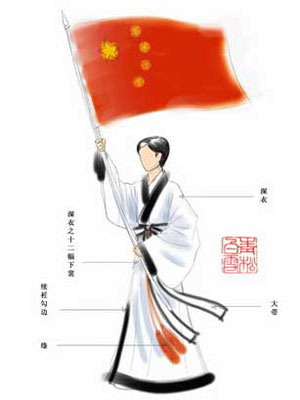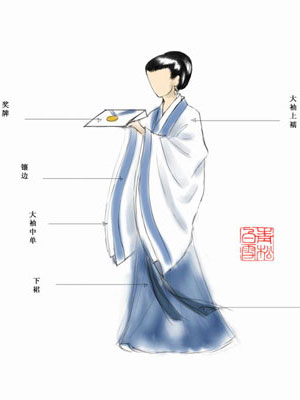Traditional dress uniform for Chinese athletes in 2008?
By Coldness Kwan (Chinadaily.com.cn)Updated: 2007-04-06 16:40
With less than 500 days away to the Beijing Olympic Games, the discussion over what the Chinese delegation should wear on the Games ceremonies has already been in full swing. The focus is Han costume - to wear or not wear.
 The Shenyi is a full-length, one-piece robe which links the Yi and Chang together to wrap up the body. It is cut separately, but sewn together. Shenyi was named because when worn "the body is deeply wrapped up". [Photo: xinhua] |
 The Shenyi is a full-length, one-piece robe which links the Yi and Chang together to wrap up the body. It is cut separately, but sewn together. Shenyi was named because when worn "the body is deeply wrapped up". [Photo: xinhua] |
A joint proposal was posted on Thursday by some websites relating to Chinese tradition and culture on their forums to favor Chinese traditional dresses "Shen Yi" and "Han Fu" as the unified uniform for the Chinese sports squad and ritual staffs on ceremonies.
According to the proposal, "Shenyi", a main dress passed down from Shang Dynasty (17th - 11th century BC) to Ming Dynasty (1368 - 1644) is the symbol of the traditional dress of the Chinese nation. Chinese sports delegation on the opening and closing ceremonies and ritual staffs on duty should wear "Shenyi" to speak volume for the Chinese culture.
"Hanfu" is recommended for the Han ethnic athletes on ceremonies to represent the culture of the most populous ethnic group of the Chinese nation.
"We promise the Beijing Olympic Games will leave a distinctive Olympic heritage to Beijing, China and the whole world," the joint proposal cited the statement of Beijing's bidding for the 2008 Olympic. "What the heritage will be is the question we must think over now," it called.
The proposal was initiated by Fu Lujiang, the master of an old-style private school called Ming De School based in Hebei Province. Fu said he won wide support after publishing an article calling for Chinese symbols at the Games last year when the Beijing Olympic ritual dress design collection was opened to public. Fu and his supporters have presented their design to the BOCOG.
The joint proposal, however, is not the only supporter for Chinese style dresses. Netizens also recommended other kinds including Qipao, Zhongshan suit and modern gown.
But some experts worried a single kind of dress may not be broadly representative of the whole Chinese nation and suggested a mixture of various kinds. Qipao originates from the Manchu ethnic group and it is not typical of the whole Chinese nation on a world stage like the Olympic Games.
Also some other experts pointed out "Hanfu" is ill-defined as it does not particularly refer to the dress of the Han ethnic group.
A professor of Beijing Institute of Clothing Technology said some changes must be made on traditional dresses before athletes wear them in order to exhibit a fine athletic spirit.
Li Xin, a fashion designer who joined the uniform design for Chinese delegation at 1988 Seoul Olympic Games said traditional uniform does not suit each of the athletes, for example, women athletes of heavyweight events may not look good in Qipao. She suggested an athlete's body type and event must be taken into account.
The discussions in forums seem to be far away from being one-sided as netizens presented various ideas. Some said China can't afford to miss such a golden opportunity as the Olympics to exhibit its rich culture while the opposing group cited reasons including the hot weather and integration with the world.
The result will not be announced by BOCOG until the Olympics 100-day countdown ceremony.
|
||
|
||
|
|